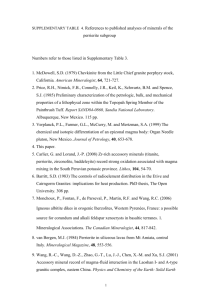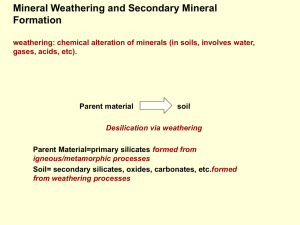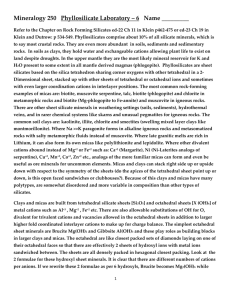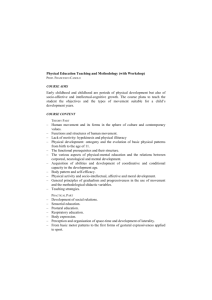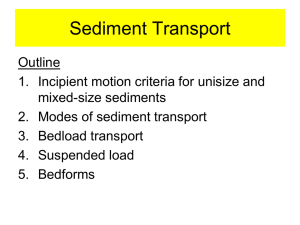Diagenesi dei sedimenti: processi e cambiamenti precoci
advertisement
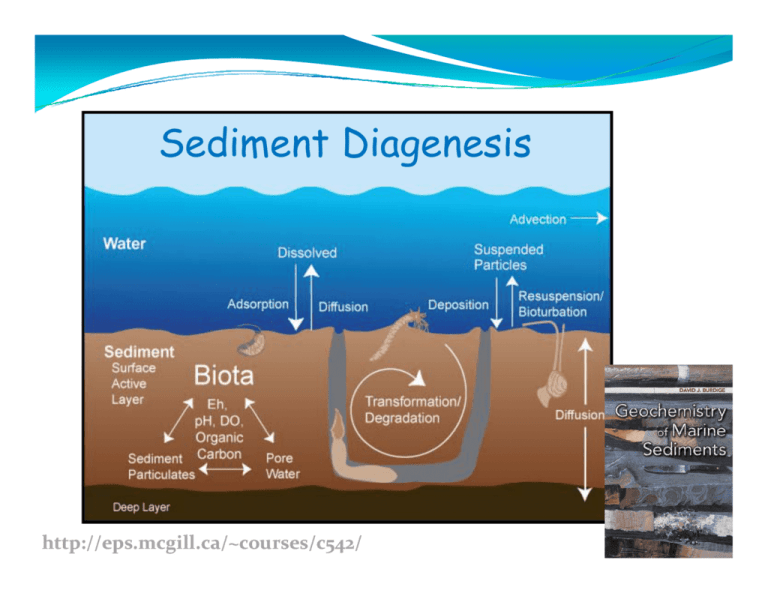
Sediment Diagenesis http://eps.mcgill.ca/~courses/c542/ S di t Di i Sediment Diagenesis Diagenesis refers to the sum of all the processes that bring about changes (e.g., refers to the sum of all the processes that bring about changes (e g composition and texture) in a sediment or sedimentary rock subsequent to deposition in water. The processes may be physical, chemical, and/or biological in nature and may occur at any time subsequent to the arrival of a particle at the sediment‐water interface. The range of physical and chemical conditions included in diagenesis is 0 to 200oC, 1 to 2000 bars and water salinities from fresh water to concentrated brines. In fact, the range of diagenetic environments is potentially large and diagenesis can occur in any depositional or post‐depositional setting in which a sediment or rock may be placed by sedimentary or tectonic processes. This includes deep burial processes but excludes more extensive high temperature or pressure metamorphic processes. l d i hi h hi Early diagenesis refers to changes occurring during burial up to a few hundred meters where elevated temperatures are not encountered (< 140 p ( 4 oC) and where uplift ) p above sea level does not occur, so that pore spaces of the sediment are continually filled with water. E l Diagenesis Di i Early 1. Physical effects: compaction. 2. Biological/physical/chemical influence of burrowing organisms: bioturbation and bioirrigation. and bioirrigation 3. Formation of new minerals and modification of pre‐existing minerals. minerals 4. Complete or partial dissolution of minerals. 5. Post‐depositional mobilization and migration of elements. 6 Bacterial degradation of organic matter. 6. B t i l d d ti f i tt Physical effects and compaction (resulting from burial and overburden in the sediment column, most significant in fine-grained sediments – shale) Porosity = φ = volume of pore water/volume of total sediment E l Diagenesis Di i Early 1. Physical effects: compaction. 2. Biological/physical/chemical influence of burrowing organisms: bioturbation and bioirrigation. and bioirrigation 3. Formation of new minerals and modification of pre‐existing minerals. minerals 4. Complete or partial dissolution of minerals. 5. Post‐depositional mobilization and migration of elements. 6 Bacterial degradation of organic matter. 6. B t i l d d ti f i tt Bi t b ti /bi i i ti Bioturbation/bioirrigation Some organisms, such as crabs and snails, mix surface sediments simply by crawling and plowing through it. More importantly, others, especially polychaete worms and bivalves, burrow into the sediment and ingest the sediment particles to extract organic matter as food Such burrowing sediment and ingest the sediment particles to extract organic matter as food. Such burrowing activity can extend to several tens of centimetres. Once their burrows are constructed, some organisms remain in them and flush the burrows with overlying seawater, bringing about enhanced exchange between pore waters and overlying seawater. This process is referred to as bioirrigation. E l Diagenesis Early 1. Physical effects: compaction. Ph i l ff i 2. Biological/physical/chemical influence of burrowing organisms: b bioturbation b and bioirrigation. db 3. Formation of new minerals and modification of pre‐existing minerals. 4. Complete or partial dissolution of minerals. 5. Post‐depositional mobilization and migration of elements 6. Bacterial degradation of organic matter. Ion exchange on the surface and intrasheet layers of clay minerals Authigenic minerals Framboidal pyrite Carbonate cement 5 μm Chert 2μ μm E l Diagenesis Early 1. 1 Physical effects: compaction. Physical effects: compaction 2. Biological/physical/chemical influence of burrowing organisms: bioturbation and bioirrigation. and bioirrigation 3. Formation of new minerals and modification of pre‐existing minerals. i l 4. Complete or partial dissolution of minerals. 5. Post‐depositional mobilization and migration of elements. 6. Bacterial degradation of organic matter. Bi i sediments di t Biogenic CaCO3 SiO2 100 µm Coccolithophores Foraminifera 100 µm From: http://www.ucl.ac.uk/GeolSci/micropal/foram.html 10 µm Diatoms 25 µm Radiolaria 10 µm 25 µm Saturation state of the oceanic water column Ω Aragonite Ω Calcite 0 2 4 6 0 1000 1000 2000 2000 Depth (m) Dep pth (m) 0 3000 6000 1 2 3 4 5 3000 4000 4000 5000 0 N. Atlantic N. Pacific 5000 N. Atlantic N. Pacific 6000 We will also see how carbonate mineral dissolution is closely linked to the oxidative degradation of organic matter. O li silica ili Opaline -1 Ni (nmol kg ) 0 0 2 4 6 8 10 12 0 -1 -1 PO 4 (μmol kg ) SiO 2 (μmol kg ) 50 100 150 200 0 1 2 3 DEP PTH (m) 1000 0 1000 2000 2000 North Pacific 3000 3000 North Atlantic 4000 North Pacific 5000 4 North Pacific North Altantic 4000 North Atlantic 5000 Unlike CaCO3, all the oceanic water column is undersaturated with respect to p amorphous silica but only a fraction (<50%) of this material dissolves in the water column as it falls through it after the death of the organisms. Most of the opal dissolution occurs at the seafloor. E l Diagenesis Early 1. Physical effects: compaction. Ph i l ff i 2. Biological/physical/chemical influence of burrowing organisms: b bioturbation b and bioirrigation. db 3. Formation of new minerals and modification of pre‐existing minerals. 4. Complete or partial dissolution of minerals. 5. Post‐depositional mobilization and migration of elements. 6. Bacterial degradation of organic matter. P d l remobilization bl Post-depositional While some elements escape the sediment through advection of pore waters as a result of compaction, many others migrate in and out of the sediment by diffusion, driven by d b d ff d b concentration gradients established as a result of diagenetic processes such as mineral dissolution ion exchange and mineral dissolution, ion‐exchange, and bacterial degradation of organic matter. E l Diagenesis Early 1. 1 Physical effects: compaction. Physical effects: compaction 2. Biological/physical/chemical influence of burrowing organisms: bioturbation and bioirrigation. and bioirrigation 3. Formation of new minerals and modification of pre‐existing minerals. i l 4. Complete or partial dissolution of minerals. 5. Post‐depositional mobilization and migration of elements. 6. Bacterial degradation of organic matter. l processes Anabolic f catabolic b l reactions Sequence of In the presence of free O2: (1) Aerobic respiration: (CH2O)106(NH3)16H3PO4 + 138O2→H3PO4 + 16HNO3 + 106CO2 + 122H2O ᇞG (kJ/mol) -475 In the absence of free O2: (1) Denitrification: (CH2O)106(NH3)16H3PO4 + 94.4HNO3→H3PO4 + 55.2N2 + 106CO2 + 177.2H2O -448 (1) Manganese reduction: (CH2O)106(NH3)16H3PO4 + 236MnO2 + 472H+→H3PO4 + 236Mn2+ + 16NH3 + 106CO2 + 366H2O -349 (1) Iron reduction: (CH2O)106(NH3)16H3PO4 + 212Fe2O3 + 848H+→H3PO4 + 424Fe2+ + 16NH3 + 106CO2 + 530H2O -114 (1) Sulfate reduction: (CH2O)106(NH3)16H3PO4 + 53SO422−→H3PO4 + 53S22− + 16NH3 + 106CO2 + 106H2O -77 77 In the absence of free and linked oxygen: (1) Disproportionation: (CH2O)106(NH3)16H3PO4→H H3PO4 + 16NH3 + 53CO2 + 53CH4 -58 58 f catabolic b l reactions Sequence of From: Gaillard JF (1999) d h Oxygen penetration depth From: Mouret et al. (2010) Deep-Sea Research I, 57: 528-540. O t ti d th Oxygen penetration depth 1. Oxygen content of the overlying waters 2. Porosity 3. Rate of organic matter catabolism ‐ Organic matter content ‐ Reactivity of the organic matter ‐ Temperature From: Burdige (2006) Geochemistry of Marine Sediments) d h Oxygen penetration depth From: Middelburg et al. (1997) Deep-Sea Res. I 44: 327-344 From: Burdige (2006) Geochemistry of Marine Sediments f catabolic b l reactions Sequence of Oxic Suboxic Sulfidic Anoxic d zonation Redox From: Froelich et al. (1979) GCA, 43: 1075-1090. From: Burdige (2006) Geochemistry of Marine Sediments
